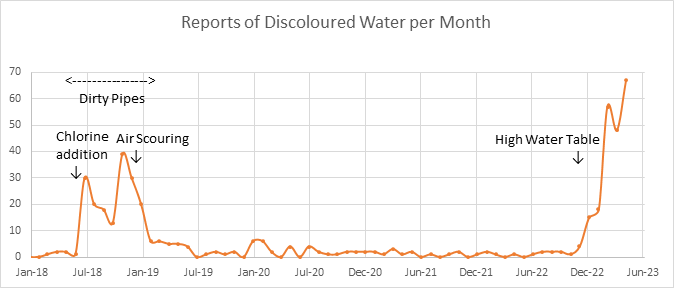Ongoing Issues with Discoloured Water
Kawerau District Council is aware of the ongoing issues with discoloured water that have escalated in recent months. There has been more service requests lodged and residents have also been advising elected members and staff via other forums.
Council apologises for these ongoing issues and the impacts on whānau. We appreciate that it is frustrating and impacts residents’ lives.
A media release was published on 7 June 2023 initially addressing the complaints of the discoloured water.
What is Council doing about the discoloured water?
We are working through a process of elimination.
It is likely there are a number of causes:
- We believe the extreme rainfall has a direct correlation with the latest spike of discoloured water reports.
- On Friday 9 June, test results of the mineral levels in the three water sources that Council utilised returned some interesting results.
- The manganese levels in Te Wai o Marukaa | Pumphouse Spring are almost four times higher in 2023 (0.20mg/Litre) than in 2021 (0.05mg/Litre).
- The New Zealand Drinking Water Standards allows for a Maximum Average Value (MAV) of 0.40mg/Litre.
- The manganese levels in Umukaraka Spring 0.0005mg/L and in Tarawera Bores 0.00015mg/L
Council is taking the following actions.
1. This latest spike in discoloured water, which is still sporadic (somewhat random) has prompted the Three Waters Team to evaluate the water sources as an elimination process. Council has used three sources for drinking water: Umukaraka Spring (Holland), Te Wai o Marukaa or Pumphouse Spring and the Tarawera Bores. In the previous three weeks, Council only utilised the Te Wai o Marukaa / Pumphouse Spring to see if the possible cause is Umukaraka Spring or Tarawera Bores. After receiving the test results on Friday 9 June 2023, Council switched the water source solely to the Tarawera Bores which it will use for a period of three weeks. We are hopeful that this will return a positive result, once the current water from Pumphouse Spring is used by residents, and/or flushed through the system and the reservoirs are refilled with water solely from the Tarawera Bores. Council also intends to revisit the availability to use Umukaraka Spring with the landowners. Albeit, this spring is currently flooded due to the extreme rainfall, so may also have issues with regard to surface water.
2. Since our Long Term Plan was adopted in 2021, Council has been completing a planned replacement program of our drinking water pipes. This is a $12 million program over six years finishing in 2026-2027. Council has brought forward key parts of the program in areas that may cause colour such as the Monika Lanham trunk main line. This work has been brought forward from 2025/26 to 2023/24.
3. Cleaning of all reticulation and valves on an ongoing basis. Council has also been flushing pipes in streets – some months the team has flushed hydrants in 56 locations.
4. Cleaning out the district’s three reservoirs.
5. Evaluating water treatment options and processes. Council is evaluating the use of lime in its process and replacing it with other methods. Council is also rebuilding the main pump station with modern energy efficient pumps and valves.
6. Testing different treatment processes. Council has used lime to balance the pH levels of the water in the past and is about to trial other methods of balancing this.
What is the cause of the discoloured water?
The issue began after Council was directed by the Bay of Plenty Medical Officer of Health Dr Phil Shoemack to chlorinate the town’s drinking supply on 1 July 2018 (see graph below). This caused a spike of issues as the longer-term build-up of manganese and iron deposits on the inside of the reticulation (drinking water pipes) caused a browning of the water due the chlorine.

Graph Explanation:
1 July 2018 - Kawerau District Council receives directive from Bay of Plenty Medical Officer of Health Doctor Phil Shoemack to chlorinate the drinking water supply. (This triggers the release of the discoloured water as chlorine reacted with the mineral deposits of manganese and iron on the pipes)
Jan-June 2019 - Council commences an air scouring program for the entire reticulation network. The number of dirty water reports drop sharply.
October 2022 - Extreme Rainfall period begins.
Jan/Feb/Mar - Rising numbers of reports mirror rainfall.

Graph Explanation:
This graph shows the reports of discoloured water versus the amount of maganese in the water supply.